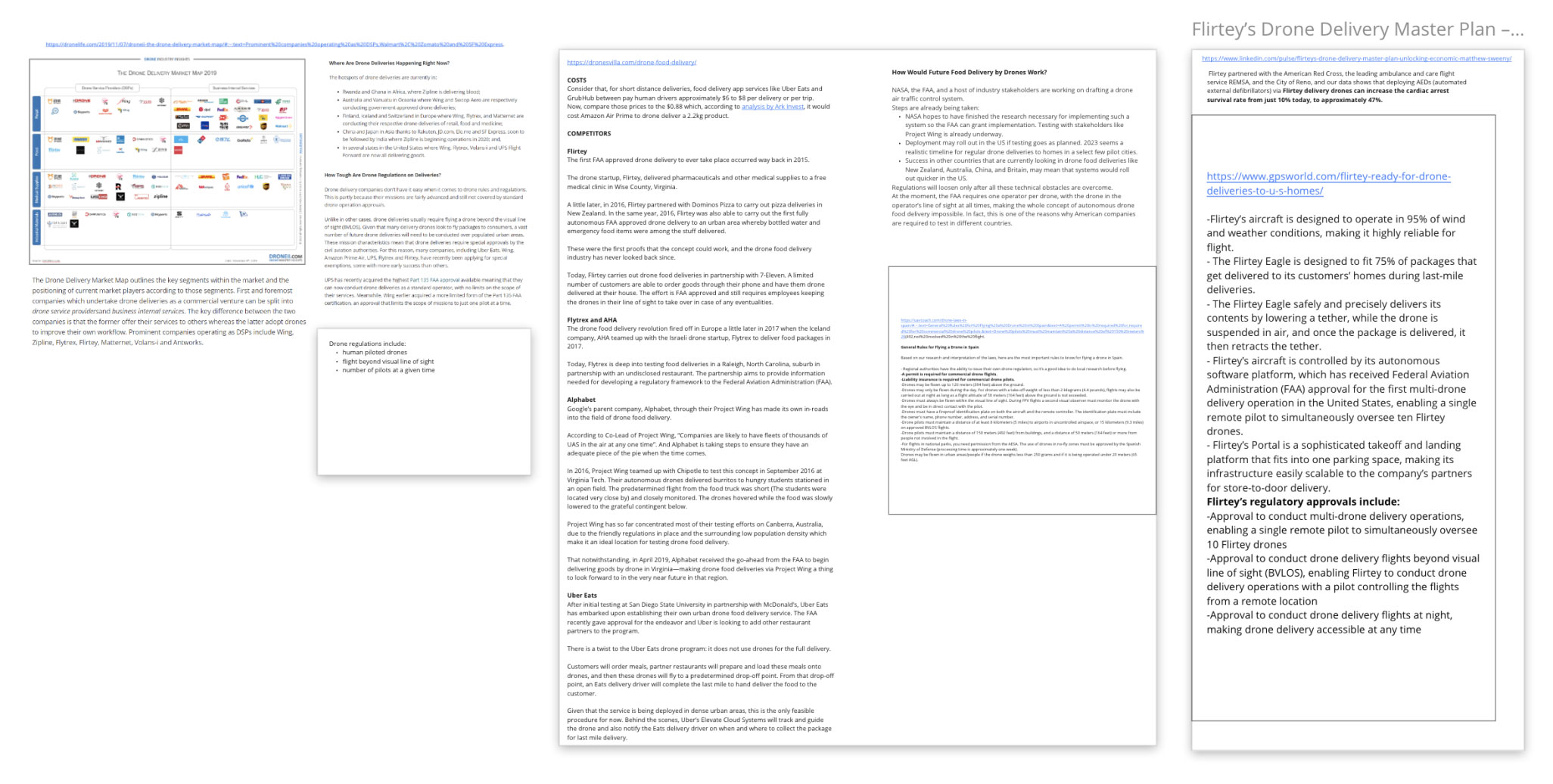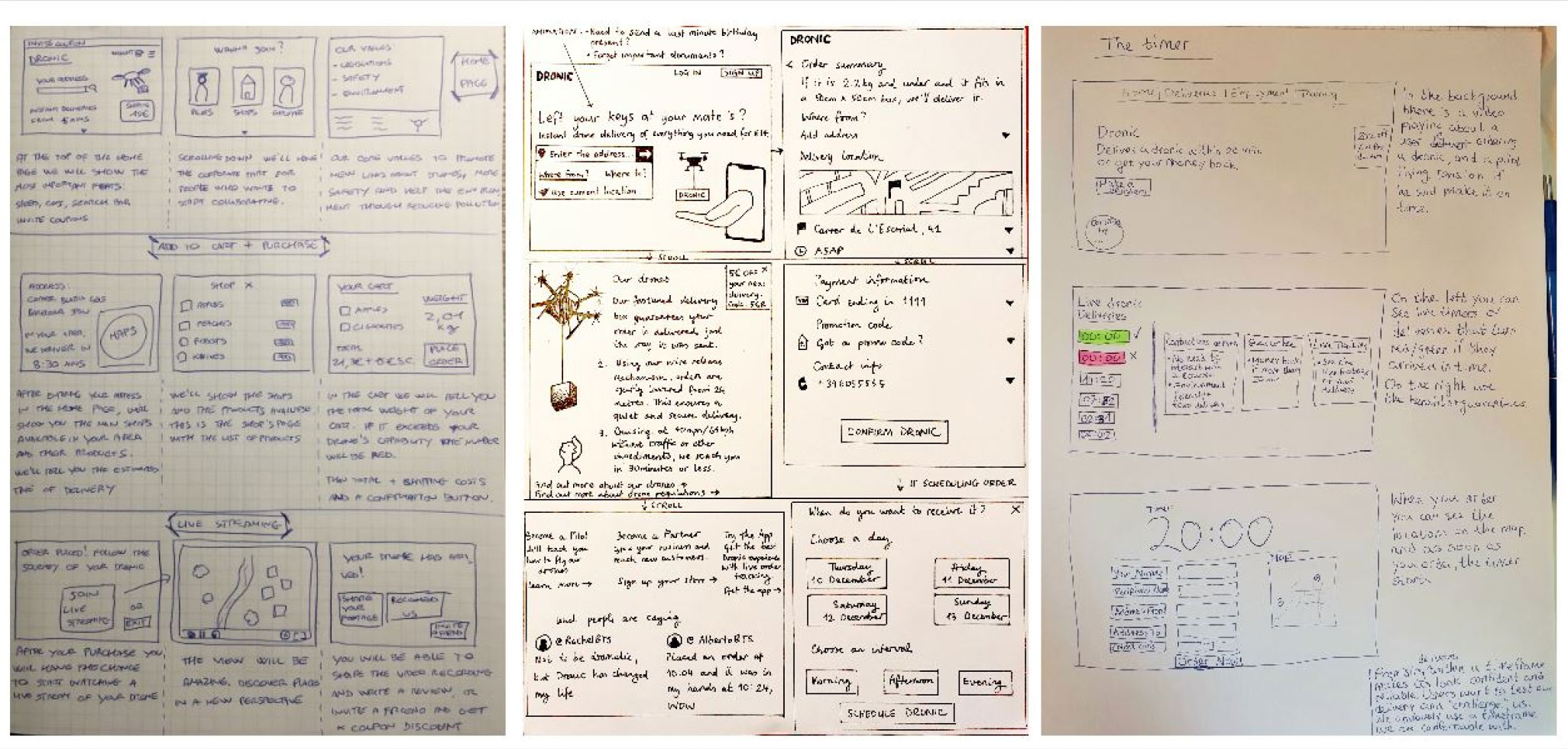
Dronic
Drone delivery service offering instant deliveries so that you can send important packages to others across the city exactly when you need to.
Date
Dec 2020My Role
UX / UI Design Lead, Project LeadTeam
Anna Nguyen, Rachel Iczkovits, Alberto Pinardi1.0. Overview
I was UX / UI Design Lead and Project Lead in a Masters in User Experience Design project to create a proposal for a new business idea.
Aside from leading the team in all stages, my individual contributions to the project were:
-Presented the business model
-Facilitator and contributor in a 5-day remote design sprint
2.0. The challenge
Our goal was to create a product or solution that would solve a problem and offer exceptional value, benefitting a target user group, using UX-driven product strategy and by conducting a 5 day design sprint with rapid prototyping and testing.
3.0. The solution
We ideated and created a business proposal and high-fidelity prototype website for Dronic, a drone delivery service. Dronic provides customer-to-customer drone deliveries and hires drone pilot hobbyists who can earn some extra money while piloting the Dronic fleet.
Our mission is to improve everyone's lifestyles by offering them instant deliveries so that people can send important packages to other people across the city, exactly when they need to.
Prototype
Wireframes
4.0. Discover
In an initial brainstorming session, I proposed to the team to base our solution on drone delivery services and we reached a consensus to proceed with this idea. We then conducted exploratory desk research on relevant, inspirational information to deep dive into the industry and learn more about drone technology.
4.1. Define
We used the Google HEART framework to set UX goals:
We also created a Business Model Canvas which helped us to understand if the problem or opportunity behind our business idea is worth solving. As part of our Business Model Canvas, we defined our value propositions:
4.2. Develop
5-day remote design sprint
The sprint is a 5-day process for answering crucial questions through prototyping and testing ideas with customers. Prior to the design sprint each team member was assigned with an area to research extensively and present insights during the first sprint session.
As facilitator, I gave a presentation to the team to kick off the sprint and explain the structure of each of the 5 sessions, and we went into Day 1 of the sprint with our challenge statement:
With Dronic, the drone delivery service, we want to improve people’s lifestyles by offering them instant deliveries to beat traditional methods, so that they can send packages across the city to others exactly when they need to.
Day 1 - Map
During the first day we focused on finding the right “path” for our project. We mapped out the actors in the Dronic ecosystem and their touchpoints. Then we carried out the presentation session, related to technology, business and customers, during which we captured ‘How Might We’ questions.
Our optimistic long-term goal showed that Dronic could become a revolutionary and disruptive solution in the delivery ecosystem, while the pessimistic viewpoint suggested some pain points: safety, affordability, competitors, and the need to adapt in order to expand the business. The two main questions we decided to focus on for the sprint were:
Will we be able to attract enough customers with our price?
Will customers think our service is reliable and safe to use?
Day 2 - Sketch
Day 2 was all about solving the problem, using a method optimized for deep thinking. Each one of us sketched our own detailed, solutions, following a four-step process that emphasizes critical thinking over artistry. We started by first collecting and synthesizing existing ideas that we can learn from. After that, we started the four-step sketch culminating in 3 solution sketches.
Day 3 - Decide
We created a heatmap of ideas that we liked from the solution sketches and based on that outcome, we decided on a final solution that incorporated features from all 3 sketches. We then voted on a user journey consisting of the very first encounter with our service (through an online article or a web search for “send urgent parcel”) to visiting the homepage, scheduling a delivery, tracking, and receiving that final delivery. This storyboard became the blueprint for our prototype.
Day 4 - Prototype
Day 4 was dedicated to the creation of our prototype - a website that allows users to discover our service, different solutions for customers, pilots, and partners, and also to schedule a delivery from one address to another.
We split the website prototyping into 3 sections with each team member working on a section:
-Home page: contains details about the service (sending a package with a drone), the main features for different customers (pilots, business owners and app users) and a detailed explanation about how our drones operate safely. Feedback is also vital, so we included a review section in the homepage to generate trust and reliability.
-Order page: we gave the users the option to schedule a delivery for a specific day and time frame or to receive it “ASAP”.
-Tracking page: once the order is placed, users have the novel possibility of watching the flight of the drone on live streamed footage and discover places from a new perspective. Finally, they can leave a review, share the drone footage to their social media networks, or recommend Dronic to a friend.
The section I was individually responsible for was the home page, and I also led the team in the whole prototyping phase, supporting them in the prototype creation and creating the UI style.
4.3. Deliver
After finishing the prototype we spent time testing it on Day 5, with each team member interviewing one user about the usability of our website and for validation of our sprint questions. Moreover, we looked for feedback about the overall concept and its feasibility.
I wrote the usability testing guidelines which included questions for the team to ask during the interviews. Insights from the interviewees showed that we can fulfil both of our initial sprint questions:
Will we be able to attract enough customers with our price?
YES. Users responded positively to the price we ask for our service. Dronic is perceived as a service to use for emergencies or rapid deliveries. For this reason, users agree the price of 15 Euros is reasonable.
Will customers think our service is reliable and safe to use?
YES. After some initial scepticism from some of our interviewees, the prototype succeeded in communicating our service and safety measures, making the users trust in it by the end of the process. Including cutomer reviews also played a key role in generating trust in Dronic services.
5.0. Next steps
Additional questions we were able to answer as a result of the design sprint and user testing were:
Can we reach our long-term goal and metric with this approach?
MOST LIKELY. We would need to invest in more drones and different models with more advanced capabilities in order to successfully grow the business and offer our service to new cities.
Do we need another design sprint? If so, what do we need to learn?
YES. With an iteration of the prototype for better usability in certain sections of the website, and conduct another round of user interviews for validation.
I believe that the experience of the design sprint proved to be a very effective process of prototyping and my role both as contributor and facilitator taught me to trust in the process, targeting those crucial questions, and the results speak for themselves. I also found myself in a position of mentorship of my team members and strengthened my leadership skills through the experience of project.











